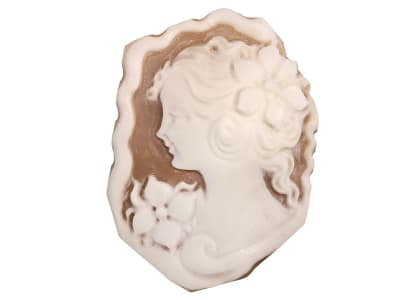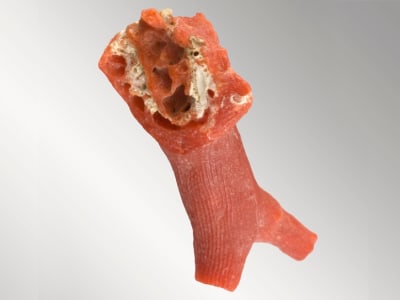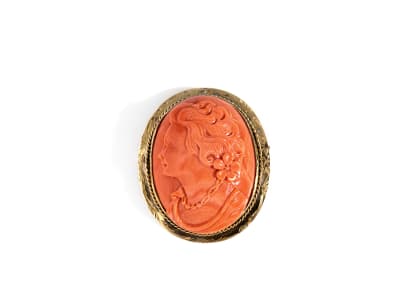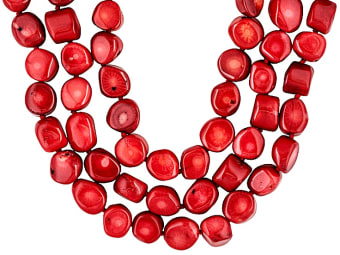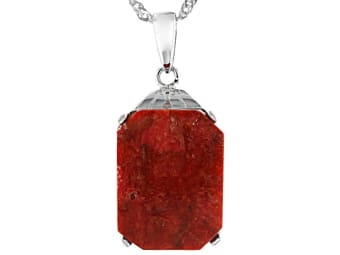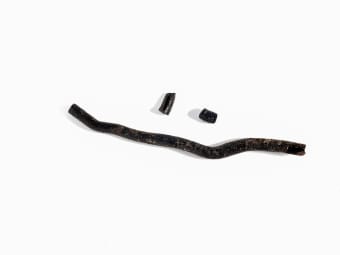Coral is a well-known gemstone prized throughout history. Corals are marine invertebrates that live in colonies that secrete calcium carbonate that form coral reefs. Corals form in branch-like structures that resemble trees. There are hundreds of species of corals but only a few are used in jewelry manufacture. Corallium rubrum and Corallium japonicum are the two varieties of red precious coral most often found in jewelry. Most corals are calcareous coral, and it is a biogenic gem material which means it was derived from a living organism. Black coral is a proteinaceous coral that is composed of conchiolin instead of calcium carbonate. Proteinaceous coral is considered an organic material. Organic gemstones are biogenic materials composed of organic matter. The pink and red colors in coral are attributed to carotene. Coral is harvested from the coastal waters surrounding Australia, Japan, Malaysia, the Philippines, and Taiwan. Coral is also harvested in the Mediterranean and Red Seas.
General Information
Tolerance:(+0.010/-0.010)
LWUV: White:inert to weak to strong bluish whiteLight and dark orange, red and pink: inert to orange to pinkish orangeDark red: inert to dull red to purplish red
Calcarous: CaCO<sub>3</sub>
Proteinaceous: C32H48N2O11
Coral Colors
-
 Black
Black -
 Blue
Blue -
 Brown
Brown -
 Orange
Orange -
 Pink
Pink -
 Red
Red -
 White
White -
 Yellow
Yellow
Alternate Names
Black Coral, Golden Coral, King's Coral, Akori Coral
Countries of Origin
Viet Nam; Japan; Philippines; United States of America; Egypt; Malaysia; Thailand; Taiwan (Province of China); India; Malta; Spain; New Zealand; Morocco; Unknown; China; Italy; Mexico; Cabo Verde; Australia; Tunisia; Indonesia
History
There is evidence for trade of Mediterranean coral throughout central Europe in the Neolithic age. A coral necklace that dates to the Neolithic period (6200-5900 BCE) was found in the Gavà Mines in Spain. Coral artifacts are often found at Celtic sites dating between 600 and 100 BCE. The legend of Perseus in Greek mythology recounts that coral was created when Perseus laid Medusa's severed head down in the water and her blood turned the seaweed into coral. In the 1500’s the Portuguese traded coral with the Yoruba and Bini peoples of West Africa. Coral is a favorite material used in religious objects and several coral amulets from the 17th and 18th century are in the British Museum.
Care
Normal, gentle care. Avoid ultrasonic cleaners, steam and extreme heat.
More About Coral
In Hinduism, Jainism and Buddhism coral is one of the nine sacred gems or Navaratna. Coral is listed with pearls in the Quran. The ancient Greeks believed that it could be used to ward off evil. The Romans believed that coral could protect children from harm and sickness. In Buddhism it is thought to bring prosperity and wellness. It is one of the Navajo eighteen sacred objects. It is used in India as an aphrodisiac.
Simulants
Gilson Imitation Coral
Gilson imitation coral is a manmade coral simulant made from calcite and silica, it requires heat and pressure to create the final product. It does not exhibit the natural grains often visible in true coral and shows fine granulation under magnification.
Species/Variety
Lace Coral
Lace Coral are common corals from the Sylasteridae family and have aragonite skeletons. They are rarely seen in the jewelry trade, but they are sometimes stabilized and dyed to simulate precious coral. Lace coral branches are fragile and grow in a broad, flat, single planes. The skeletons are orange, pink, purple, tan or white and can be quite vivid in color. Lace coral was added to CITES Appendix II in 1990. Appendix II lists species that are not currently threatened but may become endangered if trade is not controlled. Export permits or re-export certificates are required, and some countries require importation permits.
Fossil Coral
The oldest known corals date back to 500 million years ago. In fossil coral the aragonite of the original structure is replaced by calcite or agate. The fossilization process preserves the ancient corals and makes very attractive cabochons that can be used in jewelry. Most fossilized coral in jewelry has been replaced with agate.
Aka, Moro, or Oxblood Coral
Aka, moro, and oxblood are trades names for the <i>Corallium japonicum</i> species of calcareous precious coral. The Italians use the name “Moro” to describe this type of coral. The Japanese call it “<i>Aka</i>” after the Japanese word for red. The fan shaped branches have a white interior and light purplish red, dark red to very dark oxblood red exterior. It is the most expensive variety of coral and is used in premium jewelry pieces. Large vividly colored material is rare and highly sought after. This species is harvested in the waters off Japan and Taiwan. There are colonies off Cape Ashizuri and Okinawa, Japan. The coral is harvested from depths between 80 to 300 meters. The trunk of the diameter can be between 5 to 25mm in diameter.
Sardinian or Mediterranean Coral
Sardinian or Mediterranean coral is the name for the <i>Corallium rubrum</i> calcareous coral species. It is harvested from the coast of Sardinia, the Mediterranean Sea, the Atlantic coast of North Africa, the Canary Islands, and the Republic of Cape Verde. It was an early trade good and historic artifacts can be found in equatorial Africa, the Middle East and Asia. It is a small branch coral that is bush shaped, and the trunk will only grow to about 8mm in diameter. It is prized for its uniform crimson red color but can also be orangey pink and red. Most beads typically fall between 5 to 7mm in size. It can be found between 50 to 1000 meters in depth but the General Fisheries Commission for the Mediterranean bans harvesting coral in the waters off Italy, Cyprus, and Egypt in depths below 1000 meters. Coral can only be harvested by scuba divers in designated areas and the trunk size must exceed 7mm in diameter.
Dead Coral or Sciacca Coral
Dead coral or Sciacca coral is the name for the <i>Corallium rubrum</i> calcareous variety found from the Strait of Sicily. Volcanic activity between 300 BCE and 1831 formed Ferdinandea Island off the coast of Sciacca, Sicily, Italy. The island is continually eroded away, and it is currently under water. Coral reefs grew up around the island, and due to different geological events, the coral branches were broken off and settled on the sea floor. Pockets of coral were found about 1870 and they were estimated to contain 14,000 tons of coral. Studies have shown that the coral dates to between 2700 and 3900 BCE. Sciacca coral was very popular in 19th century Neapolitan jewelry and decorative objects. Most of the deposits in the area have been depleted but other pockets of similar coral have been found near Sardinia, Italy and off the coast of Malta and the Alboran Sea. The branches are fan shaped and the trunk has a maximum diameter of 5mm. The color can be vibrant orange, salmon pink, pink, orange-red, and red. Sometimes the material will show scorched marks from volcanic activity.
Angels' Skin, Bokè or Magai Coral
Angels' skin, "bokè" or "magai" coral is the albino variety of <i>Pleurocorallium elatius</i> species of calcareous coral. It is pink or flesh colored with a white interior or “soul”. It typically has uniform color with some variegation. It is called "pelle d’angelo" or "bello" in Italy and "magai" or "boké" in Japan. It can be found in Japan and Taiwan at depths between 150 to 300 meters. The coral is fan shaped and the trunk can be between 10 to 50 mm in diameter. It is used in high end jewelry, and it can take decades to find matching beads for a necklace.
Momo, Cerasuolo, and Satsuma Coral
Momo, cerasuolo, or Satsuma coral is the <i>Pleurocorallium elatius</i> variety of calcareous coral. It grows in Japanese and Taiwanese waters at depths between 150 to 350 meters. It is the largest variety of precious coral and comes in red, bright red, dark pink, salmon, orange and flesh colors with a white core or “soul”. It is known as "cerasulo" in Italy and "momo" (peach) in Japan. The coral is fan shaped and the trunk can be between 10 to 50 mm in diameter. It is sought after for use in high end jewelry and it has long been a favorite carving material in Asia. The Japanese have 4 different grades for <i>momo</i> coral. The grades are <i>seiki</i> or grade A collected alive, <i>ichi-kari</i> or grade B collected dead but still situated in its natural position with minimal deterioration, <i>ni-kari</i> or grade C dead coral that has been collected from the sea floor, and <i>san-kari</i> or grade D dead coral that has undergone significant deterioration.
Pure White or Shiro Coral
Pure white or shiro coral is the <i>Pleurocorallium konojoi</i> variety of calcareous coral. It is called “Bianco” in Italy and “Shiro” (white) in Japanese. It is harvested offshore the island of Hainan in the South China Sea, Vietnam, and the Northern Coast of the Philippines at 80 to 300 meters. It is mostly white but can have red or pink spots. The coral is fan shaped and the trunk can grow up to 25 mm in diameter. It is the least harvested species of precious coral and in 2016 it was reported that only 1 ton of white coral was harvested. In March 2017 it was listed as near threatened on the Red List of Threatened Species in Japan and it is listed on CITES Appendix III of species that are not yet endangered but needs to be monitored. In 2016 the Precious Coral Protection and Development Association began a project to transplant branches of white coral to insure the future of the species with some notable success.
Midway Coral
Midway coral is the <i>Pleurocorallium secundum</i> variety of calcareous coral. It grows offshore the Midway and Hawaiian Islands at depths between of 400 to 600 meters. It is also called rosato, bianco rosa, white or pink coral. The white or pink color is uniform or veined sometimes with red or pink spots. The coral is a fan shaped and the trunk can be 8 to 20 mm in diameter. It was first reported off Midway Island in 1965 and 1966 it was discovered off Makapu`u Point, Oahu, Hawaii. No fishing has been reported since 2001 due to the high cost of harvesting the material. It is listed on CITES Appendix III of species that are not yet endangered but needs to be monitored. It is sometimes mistaken for angel skin coral.
Deep sea, Shinkai, or Shinkay Coral
Deep sea, shinkai or shinkay coral is the <i>Hemicorallium laauense</i> variety of calcareous coral. It was harvested from the coast of Midway Island and the northwest of the Hawaiian Emperor seamount chain at depths between 1000 to 2000 meters. Coral harvesting in Hawaii is highly regulated and the coral farming industry is currently dormant. It has a uniform bright white or pink color with red veins or spots. The coral is fan shaped but lacks primary or secondary branches. The trunk can be 5 to 15mm in diameter.
Garnet coral
Garnet coral is the <i>Hemicorallium regale</i> variety of calcareous coral that can be found offshore Hawaii at depths between 350 to 600 meters. It is a uniform purplish pink to pomegranate color. It is typically small in size, and the trunk is 4 to 10mm in diameter. Due to the high cost of harvesting the trade is currently dormant.
Misu, Missu or Miss Coral
Misu, missu or miss coral is the <i>Hemicorallium sulcatum</i> variety of calcareous coral. It is found in the waters off the Philippines, Taiwan, and Japan at depths between 100 to 300 meters. The branches have uniform white, pale pink, pink to violet color with few defects. The coral is fan shaped with a trunk that can be up to 15mm in diameter. The small spines are distributed in long rows with numerous terminal twigs. It is used in high end jewelry pieces.
Bamboo Coral
Bamboo coral is a common calcareous coral from the <i>Isididae</i> family (subclass <i>Octocorallia</i>). There are 38 genera in the <i>Isididae</i> family that are found worldwide. They are segmented with off white or pale brown calcareous internodes and dark black or brown keratinous nodes that resemble the structure of bamboo. The coral is frequently bleached and dyed orange, pink or red to imitate the <i>Coralliidae</i> type of precious corals. The coral can grow to 10 meters in length and sometimes resembles a candelabra. It is sometimes called “Chinese coral”, “sea bamboo coral”, or “jointed coral”. Bamboo coral is very abundant and is not listed under CITES.
Sponge Coral
Sponge corals are common calcareous corals of the <i>Melithaeidae</i> family. There are about 101 species of coral in the <i>Melithaeidae</i> family found in the shallow waters of Indo-Pacific regions. The coral has broad fan like branches and is better known in the wild as sea fans. The coral is highly porous and resembles a sponge. It is segmented with orange-red calcareous internodes and light yellow or brown keratinous nodes. Sponge coral is typically dyed and stabilized, and smaller pieces are assembled to create different shapes to be used in jewelry. It is sometimes called “Congi” or “red spongy coral”.
Black Coral
Black coral is a common proteinaceous organic coral from the order <i>Antipatharia</i>. Unlike calcareous coral it is made up of protein and chitin (a nitrogen-containing polysaccharide similar to insect exoskeletons). The order <i>Antipatharia</i> has approximately 265 species but only 13 are harvested for jewelry. It can be found worldwide but the most frequently studied are from tropical or subtropical waters. It is black or very dark brown in color, and the branches have a spiny or tree like structure. It can be bleached to create a golden color. It is also called “horn coral” or “king coral”. It has been found in ancient jewelry and religious objects in the Mediterranean area. The native Hawaiians used it to treat lung diseases and mouth sores. It is the state gem of Hawaii. Black coral is listed on the CITES Appendices II, which lists species that are not currently threatened but need to be monitored and trade of the material controlled. It is protected in the Mediterranean Sea area, India, and Indonesia. The state of Hawaii has strict regulations on the harvesting of black coral, and fishing is closely monitored.
Golden Coral
Golden coral is bleached black coral.
Alaskan and Hawaiian Gold Coral
Alaskan and Hawaiian gold corals are proteinaceous corals. Alaskan gold coral consists of four species in the genus <i>Primnoa</i>. Alaskan gold coral is currently not being harvested but it was a byproduct of halibut fishing industry in the 1980’s. It is golden brown to brown in color and it has surface ridges that run the length of the branches. The ridges give the material a similar appearance to petrified wood. The branches are tree like and can be 6mm in diameter. Even though it is a proteinaceous coral it is embedded with calcite. Hawaiian coral is a member of genus <i>Gerardia</i>. It was discovered in 1971 and was harvested off Makapu`u Point for jewelry manufacture until September 2008 when NOAA’s National Marine Fisheries Service (NMFS) moratorium on the harvesting of gold coral throughout the U.S. western Pacific. The moratorium has been extended until June 30, 2023. Hawaiian gold coral is golden in color and has a finely dimpled texture with black or dark mottling.
Blue Coral
Blue coral is the <i>Heliopora coerulea</i> variety of common coral. It is also called blue ridge coral, blue sponge coral, and denim coral. It is found in the shallow reefs of the Indo-Pacific region with the largest colonies being in Japan. Living colonies are brown but cleaned specimens are bluish gray with a darker blue interior. If blue coral is exposed to sunlight, it will become light gray. The skeleton is made up of fibrous aragonite. The coral will show large tubular pores approximately 1mm in diameter and small circular pores 0.1mm in diameter. The material is frequently stabilized and sometimes dyed to improve durability and color. Blue coral was added to CITES Appendix II in 1985. Appendix II lists species that are not currently threatened but may become endangered if trade is not controlled. Export permits or re-export certificates are required, and some countries require importation permits.
